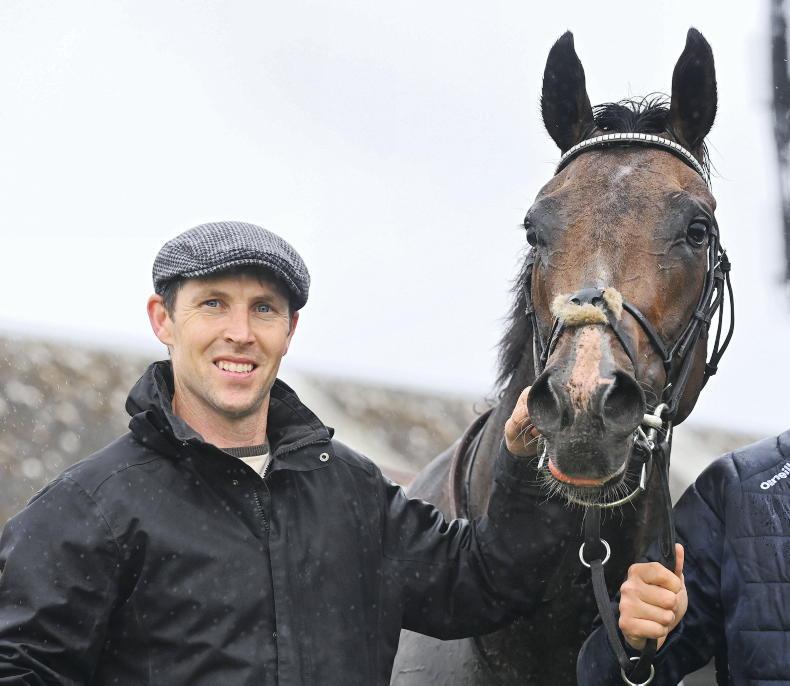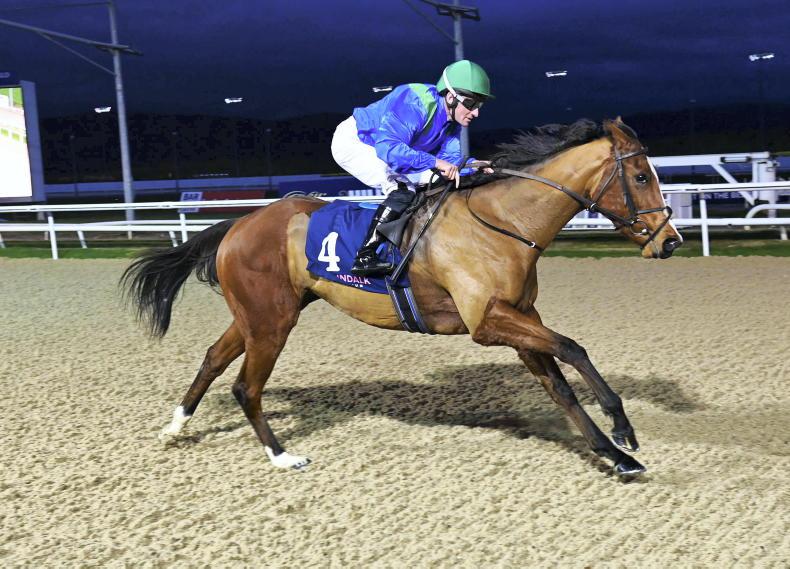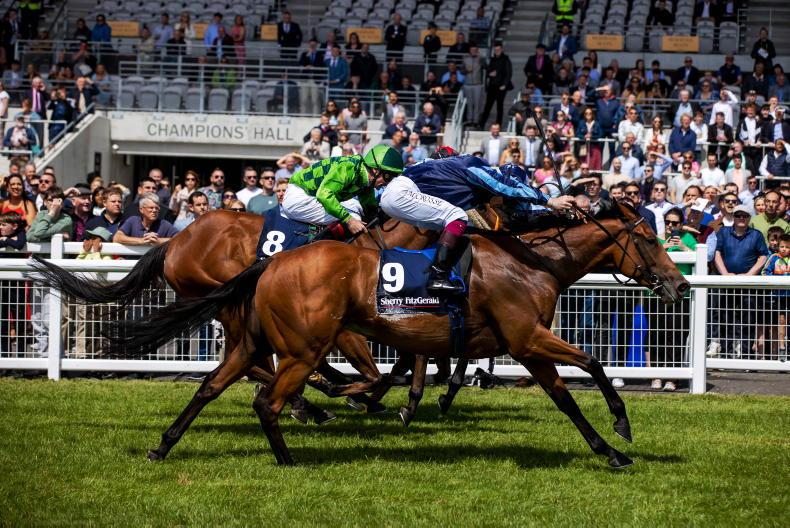THERE have been 477 trainers saddle runners on the flat in Britain this year, but none boast a more impressive strike rate on those shores than Carrick-on-Suir-based trainer Kevin Coleman.
Admittedly, the 37-year-old has made a limited number of trips across the water, but it is a sign of his operation’s upwardly-mobile profile that he has struck with four of his six runners in Britain this year - a standout 67% hit rate.

Even more striking is the fact those smart returns come from a small yard of between 18 and 20 horses. Stable flagbearer Derry Lad has been astutely campaigned to mop up back-to-back handicaps in the lucrative Sky Bet Sunday Series and is being readied for another decent pot at Haydock on August 6th, while one of his beaten runners in Britain, Catherine Of Siena, failed by just a neck in listed class when second at Chelmsford.
The former jockey, who memorably partnered Sir Frederick to success in the 2007 Galway Plate before injury shortened his riding career, will be the first to say that his early training successes have come in races a fair way from the highest echelons.
However, that does not mean his progress as a trainer going places has gone unnoticed by any means. His yard’s increasing profile has been easily spotted.
Ever since venturing to Beverely to get his first winner on the board in May 2019 with Allhallowtide, there has been steady improvement with each domestic campaign. Five winners on home soil in 2020 turned to seven a year later, and 12 in 2022 when amassing over €200,000 in prize money.
Coleman’s haul of six winners in Ireland so far this year includes a €25,000 Derby weekend success at the Curragh through useful sprinter Coumshingaun, and a first treble was nearly pulled off at Bellewstown earlier this month.

“You can be up one day and down the next in this game,” a pragmatic Coleman says.
“We won the first at Bellewstown that day with Fleetfootsoldier, got beaten a short-head in the second with West Of Wichita and we thought we had won with Only Spoofing, but he actually was beaten a nose in second. We were coming home disappointed even though we had a winner.
“Again, we had a great day last Saturday when Shoebox King won at Navan but on Sunday we had to rush to hospital with Catherine Of Siena. Unfortunately we lost her. She was by far the best horse I’ve had so far and it’s tough to take when you’re close to them in a small yard.
“Those are just a few highs and lows to take in the space of a few days. It isn’t for the faint-hearted but I’m lucky because I’ve been given great opportunities. Thankfully things are going well for us.

Retirement u-turns
“Swiss Army Officer and Red Vermillion were my first two winners of the turf season in Ireland this year. Both are eight-year-olds and have been retired on numerous occasions - Red Vermillion even had a foal before coming back to the track.
“I basically brought them back so the lads in the yard would have something to ride; I never expected them to win. It was great they got us off on the right foot. They’re in their own class but they’ve been good to me.”
As well as delivering with veterans, Coleman has made an impact in the two-year-old division. More than a quarter - 10 - of his winners were with juveniles.
He credits the backing of Demi O’Byrne, who has purchased over 70 individual Group/Grade 1 winners internationally, and bloodstock business partner Sean Grassick as being particularly influential in his success. Coleman says his latest crop of youngsters were bought at an average of approximately €20,000 each.
“I’d always have bought a few fillies and we did okay with them,” he explains.
“Sean was starting out with Demi and they had a filly who they felt possibly wasn’t good enough for the sales. I went down and bought her for half nothing, and she turned out to be [now three-time winner] Coumshingaun. They then decided to send me a few themselves.

“They know the game inside-out and have been great to deal with. They put the finance into the 10 yearlings last year and the same this year. I’d basically still be going around with Red Vermillion and Swiss Army Officer without that. Like all trainers, you need someone behind you to kick on.”
Family backing
Was a career in the training ranks always on the cards for the brother of top National Hunt jockey Aidan Coleman?
“I don’t know,” muses the former pre-trainer and breeze-up operator. “I couldn’t see how it was going to happen for me in terms of starting off. I had no money, no yard, nothing. My mother [Eileen] and father [Pat] basically bailed me out!
“I think I bought my first horse in 2008. She cost 10 or 15 grand but ended up costing about 100 grand by the time we had foals with her and so on. They were wondering what we were doing at that stage, and I had to go through quite a few of them. I kept plugging away.
“We work hard to try to get things right. I think I’ve got my mother’s genes in terms of her work ethic. She’s so driven. From as far back as I can remember, we worked all day and gave everything to what we did. My father is probably a saint to put up with my mother and I.
“From an early age, they drove us all over the country for pony racing, from the back arse of Cork to Donegal, Galway and wherever the meetings were on. They made it happen for us and never once interfered. They were both school teachers and could have pushed us down another route but I take so much drive from my mother. It can be a double-edged sword, though!”
He adds: “Aidan enjoys coming back to us here but I don’t see him doing this in the future. I think in the last few years he has learned to enjoy his riding more. He knows he’s at the latter end and is probably riding better for it.”
Eager to bring something different to the training ranks after hanging up his riding boots at age 23, Coleman embarked on a four-year degree in Sport and Exercise Science from the University of Limerick in between establishing his Co Tipperary base.
In an interview in these pages back in 2019, following his first winner, Coleman expressed an interest in incorporating data and science from his studies as a significant component in his training. His views on that topic have changed over time, though.
Data view
He explains: “We went with everything you can think of when I started: heart rate monitors, bloods and all. I had it in mind that I’d bring it in when I’m ready to go and that I’d be ahead of everyone, but I don’t use much of it at all now. It just isn’t practical. The more I learned in university, the more I realised that I hadn’t got a clue.
“You need to be open to adjusting your thinking. The long and short of it is that a good horse is a good horse and you don’t get in their way. I spent four years at it and now I effectively don’t use it.
“I’ve seen stuff being marketed to trainers but you just need to feed the horses, gallop them when they need it, keep them happy and don’t interfere with them. The rest is BS, to be honest. That’s just my opinion.
“I used heart monitors myself when I was competing in triathlons and running races, treating myself as a guinea pig. I ran the marathon, and I also did 400 metres and 800 metres, which require separate types of training as a human. Horses are completely different to humans, though.
“You can have great intentions but you have to be able to stand back, look at where you’re going and make changes. I think we have a system in place that works for the facilities we have.
“Having good staff is vital too. It’s hard to get the right people even though the money in this game is a lot better than I was four or five years ago.”
For all that the capable horseman met with injury problems during the latter stages of his time in the saddle - including three collarbone fractures in a year and a leg break back in 2009 - he describes a sliding doors moment at the 2007 Leopardstown Christmas Festival as a crucial event in his career.
He called time on riding with 87 winners under rules in Ireland, with his first big success coming at Tralee in 2005 aboard the Francis Flood-trained Monte Solaro - now best known as the dam of Altior.
‘Double whammy'
“I can remember riding a lot for John Kiely and Tom Hogan around 2007, and one day at Leopardstown I chose to ride Indian Pace over Silver Jaro in a hurdle there,” says the former midlands pony racing champion rider in his youth.
“I beat Silver Jaro a neck and won on Indian Pace, so it was the right decision. As it turned out, though, Noel Fehily kept the ride on Silver Jaro and they won the County Hurdle that spring.
“On top of that, Indian Pace won the Galway Hurdle the following summer but they wanted to claim off him and went with Paul Townend. It was a double whammy and that was enough for me. You don’t get over that.
“I know it’s all part of the game, and Paul Townend and Noel Fehily were far better riders than me - I mightn’t have won on them anyway - but you’d like to think you’d have been there. A better lad would have gotten over it but I wasn’t able to. You only get one chance.”
Against that backdrop, being able to write the next chapter in his racing life as a trainer is entitled to give Coleman a real sense of fulfilment. However, he views the increasing outside interest in his business as a shrewd handler in very straight and practical terms.
“I’m winning a few - mostly low-grade - races,” he quips.
“It is nice that there feels to be a bit of momentum building. There are plenty of lads in this country who can train but they haven’t got the same opportunities as me. In the last few weeks we’ve got more phone calls about horses than before.
“I don’t actively campaign for owners, even though I am on Facebook and Twitter. I’m not one to blow my own trumpet and it’s not my personality to be loud on social media but if people come, that’s nice. There’s no shortage of support, and that adds to the pressure of performing. I think I’m my own worst critic.
“Making the move to Carrick-on-Suir, having previously had a couple of horses at the Curragh, was a big thing. We bought a fabulous place there and, with the help of my parents and my brother, we put in the gallops. If I was still on the Curragh, there’s no chance I could do any of this because I wouldn’t have been able to afford the rent.
“I was given a good opportunity and we’ve been building on that with my wife Kim at home, Sean and Demi, as well as other supporters who have been there from the start.”
Pragmatic approach
What does the Innishannon, Co Cork native have in mind for his operation in the coming years?
“I’m a realist,” he insists. “Everything is for sale here and if they’re any good, they will be sold.
“For me, winning the selling and claiming races in Britain has been a real kick, even if the likes of Travel Candy’s win at Beverley in May was only worth around £3,500. Winning the 47-65 handicaps in the lower grades is a great buzz.

“I’ve heard trainers saying they want to win Group 1s and so on - and that’s grand - but I’m comfortable at the moment with the fact we weren’t at Royal Ascot and that I probably won’t make an entry for Galway. I enjoy winning at the smaller tracks. As long as I’m still getting a buzz out of it, that’s great.
“I’ll probably go up in numbers slightly next year. I worked for David Marnane and rode for Eric McNamara when they were going strongest. I know how things can expand and basically you don’t know how things will ever unfold in the future. I’m probably a negative person in that regard but I try to be realistic.
“Most of the horses are my own and it’s a bit easier to go home when they don’t win in that case. You don’t always have someone to explain the defeats to.”
Asked about his interests outside of racing, Coleman adds: “I know some trainers out there have been told to do something in their down time, drive racing cars or fly planes, but I don’t understand that. My hobby is racing. I don’t want to do anything else. That’s my approach.
“If you saw me coming off the stand at Navan after Shoebox King won a fairly low-key race in the lashing rain last weekend, you’d understand the thrill we get from this. Why would I want to do anything else?”
A pragmatic-by-nature Kevin Coleman may not be about to lose the run of himself any time soon when it comes to the future, but his results suggest he has a place in the training ranks for some time to come.
The marathon runner with a knack for training sprinters and stayers is certainly making tracks.
